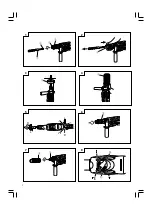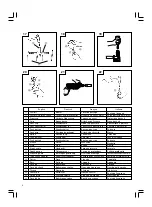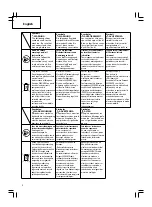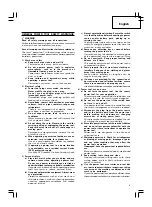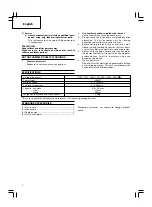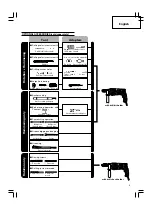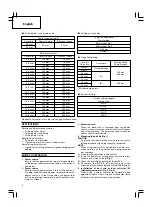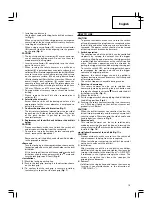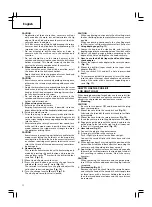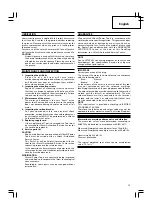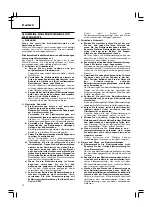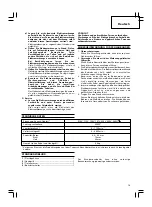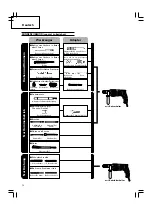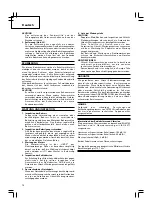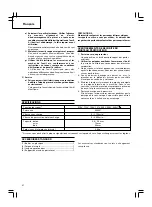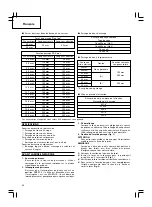
English
11
CAUTION
Application of force more than necessary will not
only expedite the work, but will deteriorate the tip
edge of the drill bit and reduce the service life of the
rotary hammer in addition.
Drill bits may snap off while withdrawing the rotary
hammer from the drilled hole. For withdrawing, it is
important to use a pushing motion.
Do not attempt to drill anchor holes or holes in
concrete with the machine set in the rotation only
function.
Do not attempt to use the rotary hammer in the
rotation and hammering function with the drill chuck
holder attached. This would seriously shorten the
service life of every component of the machine.
4. When driving machine screws
In the same manner as the drill bit is installed, install
the driver bit to the drill chuck holder.
Apply the driver bit to the groove of screw head and
turn on the switch to tighten the screw.
CAUTION
Exercise care not to excessively prolong driving time,
otherwise, the screws may be damaged by excessive
force.
Apply the rotary hammer perpendicularly to the screw
head when driving the screw; otherwise, the screw
head or bit will be damaged, or driving force will not
be fully transferred to the screw.
Do not attempt to use the rotary hammer in the
rotation and hammering function with the drill chuck
holder and bit attached.
5. When driving wood screws
(1) Selecting a suitable driver bit
Employ cross-recessed screws, if possible, since the
driver bit easily slips off the heads of slotted-head screws.
(2) Driving in wood screws
Prior to driving in wood screws, make pilot holes
suitable for them in the wooden board. Apply the bit
to the screw head grooves and gently drive the screws
into the holes.
After rotating the rotary hammer at low speed for a
while until the wood screw is partly driven into the
wood, squeeze the trigger more strongly to obtain
the optimum driving force.
CAUTION
Exercise care in preparing a pilot hole suitable for the
wood screw taking the hardness of the wood into
consideration. Should the hole be excessively small
or shallow, requiring much power to drive the screw
into it, the thread of the wood screw may sometimes
be damaged.
6. Hammering only
This rotation hammer can be set to hammering only
mode by pressing the push button and turning the
change lever to the
mark with the drill bit holder
installed. (
Fig. 12
).
(1) Mount the bull point or cold chisel.
(2) Press the push button and set the change lever to
middle of
mark and
mark (
Fig. 13
).
The rotation is released, turn the grip and adjust the
cold chisel to desired position (
Fig. 14
).
(3) Turn the change lever to
mark (
Fig. 12
).
Then bull point or cold chisel is locked.
CAUTION
When conducting continuously the chiselling work,
the heat build-up inside the rotary hammer may cause
trouble.
When conducting continuously the chiselling work
for 15 minutes, rest the rotary hammer for 30 minutes.
7. Using depth gauge (Fig. 15)
(1) Loosen the knob on the side handle, and insert the
depth gauge into the mounting hole on the side handle.
(2) Adjust the depth gauge position according to the
depth of the hole and thighten the knob securely.
8. How to use the drill bit (taper shank) and the taper
shank adapter
(1) Mount the taper shank adapter to the rotary hammer
(Fig. 16).
(2) Mount the drill bit (taper shank) to the taper shank
adapter (Fig. 16).
(3) Turn the switch ON, and drill a hole in prescribed
depth.
(4) To remove the drill bit (taper shank), insert the cotter
into the slot of the taper shank adapter and strike the
head of the cotter with a hammer supporting on a
rests (Fig. 17).
HOW TO USE THE CORE BIT
(FOR LIGHT LOAD)
When boring penerating large holes use the core bit (for
light loads). At that time use with the center pin and the
core bit shank provided as optional accessories.
1. Mounting
CAUTION
Be sure to turn power OFF and disconnect the plug
from the receptacle.
(1) Mount the core bit to the core bit shank (Fig. 18).
Lubricate the thread of the core bit shank to facilitate
disassembly.
(2) Mount the core bit to the rotary hammer (Fig. 19).
(3) Insert the center pin into the guide plate until it stops.
(4) Engage the guide plate with the core bit, and turn the
guide plate to the left or the right so that it does not
fall even if it faces downward (Fig. 20).
2. How to bore (Fig. 21)
(1) Connect the plug to the power source.
(2) A spring is installed in the center pin.
Push it lightly to the wall or the floor straight.
Connect the core bit tip flush to the surface and start
operating.
(3) When boring about 5 mm in depth the position of the
hole will be established. Bore after that removing the
center pin and the guide plate from core bit.
(4) Application of excessive force will not only expedite
the work, but will deteriorate the tip edge of the drill
bit, resulting in reduced service life of the rotary
hammer.
CAUTION
When removing the center pin and the guide plate,
turn OFF the switch and disconnect the plug from the
receptacle.
3. Dismounting (Fig. 22)
Remove the core bit shank from the rotary hammer
and strike the head of the core bit shank strongly two
or three times with a hammer holding the core bit,
then the thread becomes loose and the core bit can
be removed.
Summary of Contents for DH24PM
Page 2: ...1 1 2 4 6 8 3 5 7 1 L 2 3 4 4 5 6 7 R R L 8 8 9 A ...
Page 3: ...2 9 10 A 11 13 12 14 16 15 A A 4 D F E 1 G 3 4 C B ...
Page 58: ...57 ...
Page 60: ...59 1 2 3 4 5 ...
Page 61: ...60 ...
Page 62: ...61 ...


